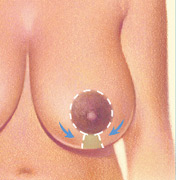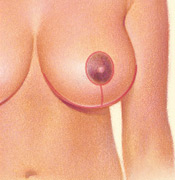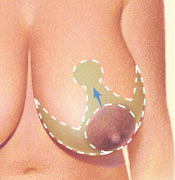The Procedure
Breast reduction involves making incisions on the breast skin to remove the excess breast tissue and skin.
In some cases, excess fat may be removed through liposuction in conjunction with the excision techniques described below. If breast size is largely due to fatty tissue and excess skin is not a factor, liposuction alone may be used for breast reduction.
The technique used to reduce the size of your breasts will be determined by your individual anatomy, breast composition, amount of reduction desired, your personal preferences and the surgeon's advice.
Step 1—Anesthesia
Medications are administered for your comfort during the surgical procedure. The choices include intravenous sedation and general anesthesia. Your doctor will recommend the best choice for you.
Step 2—The incision
Incision options include:
A keyhole or racquet-shaped pattern


An inverted T or anchor-shaped incision pattern


Step 3—Removing tissue and repositioning
After the incision is made, the nipple— which remains tethered to its original blood and nerve supply—is then repositioned. The areola diameter is reduced by excising skin at the perimeter, if necessary. Underlying breast tissue is reduced, and the remaining breast tissue is lifted and shaped. Rarely, in extremely large breasted women, the nipple and areola may need to be removed and repositioned to a higher position on the breast (free nipple graft).
Step 4—Closing the incisions
The incisions are brought together to reshape the now smaller breast. Sutures are layered deep within the breast tissue to create and support the newly shaped breasts; sutures, skin adhesives and/or surgical tape close the skin. Incision lines are permanent, but in most cases will fade and significantly improve over time.
The incision lines that remain are visible and permanent scars, although usually well concealed beneath a swimsuit or bra.
